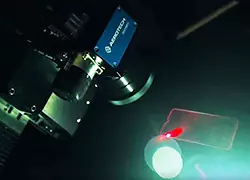In the highly specialized world of precision motion control, movement isn't limited to straight lines or continuous rotation. Often, the most critical adjustments involve small, highly accurate angular corrections to align optical paths or level sensitive samples. This need for ultra-fine angular adjustment is met by the motorized tilt stage, an essential device that provides automated, repeatable pitch and roll control for critical payloads.
To understand the core mechanics and superior angular performance that define these systems, refer to our detailed guide on the high precision rotary stage. The precise control of angular orientation is a fundamental requirement across the entire spectrum of precision stages and is key to improving fidelity in alignment and inspection tasks.
What Is a Motorized Tilt Stage?
A motorized tilt stage is a platform that pivots around one or more axes using a motor, allowing precise angular adjustments in tilt. This mechanism is specifically engineered to introduce controlled angular displacement, often over a small range of motion (typically a few degrees) but with extremely high resolution (down to microradians). The small, controlled adjustments are vital because even minor angular errors can lead to significant positional errors over long working distances.
It's commonly used in optics, microscopy and alignment applications where controlled, repeatable angular positioning is needed. The core advantage of a motorized tilt stage is its integrated control system, which allows for automated, hands-off adjustment and synchronization with other axes of motion. This capability is paramount in systems requiring complex 3D alignment or continuous feedback correction. The high level of control ensures that once an ideal angle is found, it can be returned to immediately and reliably at any point in the future, eliminating the need for tedious manual readjustment.
What Are Motorized Tilt Stages Used For?
Motorized tilt stages are used to precisely adjust the angle of components in applications like optics, laser alignment and microscopy. These systems are the backbone of many advanced scientific instruments where angular errors must be rigorously managed. In microscopy applications, for instance, they level the sample plane precisely with the lens focal plane, thereby maximizing image sharpness and uniformity. In photonics applications, motorized tilt stages help to achieve the optimal alignment between fibers to be joined.
They enable automated, repeatable tilting for tasks such as beam steering, sample positioning and optical system calibration. The ability to automate these adjustments dramatically cuts down on setup time and allows for complex iterative calibration routines that would be impossible manually. Key tip-tilt stage applications include enhancing imaging quality and accuracy in semiconductor inspection tools and high-resolution imaging systems. By providing pitch and roll compensation, tilt stages counteract mechanical and thermal drift, ensuring system performance remains high throughout the operational cycle. They are indispensable components in any system where the orientation of the payload directly impacts the quality of the final output.
How Do I Choose a Motorized Tilt Stage?
Selecting the optimal tilt stage involves carefully matching the stage’s technical capabilities to the specific angular demands of the application. Choose a motorized tilt stage or tip-tilt stage by considering your application’s tilt range, angular resolution, load capacity and required repeatability. The tilt range must be sufficient to cover the expected range of motion or angular correction, while the angular resolution dictates the fineness of the adjustment possible. Repeatability ensures that the desired angle can be reliably revisited after other movements.
Evaluate drive type, speed and compatibility with your control system to ensure precise and reliable performance. Stages using worm gears often provide high stiffness for holding a load, while direct-drive mechanisms offer extremely fast response for dynamic tracking. Load capacity must account for the mass of the payload and its distribution. For heavier components in industrial settings, high load tip/tilt stage options are available for heavier applications, which typically feature robust bearing systems and high-torque motors. Always consult with a motion control specialist to verify that the chosen system meets all dynamic and angular requirements for optimal results.
What Are the Different Types of Motorized Tilt Stages?
Motorized tilt stages come in several configurations, each optimized for specific alignment tasks. The main types of motorized tilt stages include single-axis tilt stages, which provide angular adjustment around one axis, and dual-axis gimbal stages, which allow independent tilting around two perpendicular axes in an elevation-over-azimuth arrangement. Single-axis stages are simpler and cheaper when only pitch or roll correction is needed. Dual-axis stages, often referred to as tip-tilt stages or motorized gimbals, are most common for full planar alignment.
Some designs use worm gears for stability or direct-drive motors for higher precision and speed, depending on application needs. Worm gear drives offer high reduction for very fine control while direct-drive options provide superior dynamics and speed for tracking applications. There are various types of motorized tilt stages, including 3-axis motorized stages and goniometers. Goniometers provide rotation about a point external to the stage platform. Different types of motorized tilt stages cater to specific needs in precision engineering, ensuring that whether the application requires one, two or three axes of angular movement, an appropriate solution exists to deliver the required performance.
Ready to dive deeper into the world of precision stages?


